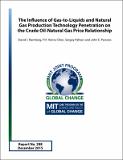The Influence of Gas-to-Liquids and Natural Gas Production Technology Penetration on the Crude Oil-Natural Gas Price Relationship
| dc.contributor.author | Ramberg, D.J. | |
| dc.contributor.author | Chen, Y.-H.H. | |
| dc.contributor.author | Paltsev, S. | |
| dc.contributor.author | Parsons, J.E. | |
| dc.date.accessioned | 2016-05-23T15:12:36Z | |
| dc.date.available | 2016-05-23T15:12:36Z | |
| dc.date.issued | 2015-12 | |
| dc.identifier.uri | http://hdl.handle.net/1721.1/102611 | |
| dc.description.abstract | The paper examines conditions under which gas-to-liquids (GTL) technology penetration shifts the crude oil-natural gas price ratio. Technologies that enable direct substitution across fuels, as GTL does, may constrain the price ratio within certain bounds. We analyze the forecasted evolution of the crude oil-natural gas price ratio over the next several decades under alternative assumptions about the availability and cost of GTL and its natural gas feedstock. We do this using a computable general equilibrium model of the global economy with a focus on the refinery sector in the U.S. Absent GTL, a base case forecast of global economic growth over the next few decades produces dramatic increases in the oil-natural gas price ratio. This is because there is a more limited supply of low-cost crude oil resources than natural gas resources. The availability of GTL at conventional forecasts of cost and efficiency does not materially change the picture because it is too expensive to enhance direct competition between the two as fuels in the transportation sector. GTL only modulates the increasing oil-gas price ratio if both (i) natural gas is much cheaper to produce, and (ii) GTL is less costly and more efficient than conventional forecasts. | en_US |
| dc.description.sponsorship | This work has been funded in part by BP, the MITEI ENI Energy Fellowship, the MITEI Martin Family Fellowship, and sponsors of MIT’s Joint Program on the Science and Policy of Global Change. The Joint Program on the Science and Policy of Global Change is funded by the U.S. Department of Energy, Office of Science under grants DE-FG02-94ER61937, DE-FG02- 08ER64597, DE-FG02-93ER61677, DE-SC0003906, DE-SC0007114, XEU-0-9920-01; the U.S. Department of Energy, Oak Ridge National Laboratory under Subcontract 4000109855; the U.S. Environmental Protection Agency under grants XA-83240101, PI-83412601-0, RD-83427901-0, XA-83505101-0, XA-83600001-1, and subcontract UTA12-000624; the U.S. National Science Foundation under grants AGS-0944121, EFRI-0835414, IIS-1028163, ECCS-1128147, ARC-1203526, EF-1137306, AGS-1216707, and SES-0825915; the U.S. National Aeronautics and Space Administration (NASA) under grants NNX06AC30A, NNX07AI49G, NNX11AN72G and Sub Agreement No. 08-SFWS-209365.MIT; the U.S. Federal Aviation Administration under grants 06-C-NE-MIT, 09-C-NE-MIT, Agmt. No. 4103-30368; the U.S. Department of Transportation under grant DTRT57-10-C-10015; the Electric Power Research Institute under grant EP-P32616/C15124, EP-P8154/C4106; the U.S. Department of Agriculture under grant 58-6000-2-0099, 58-0111-9-001; and a consortium of 35 industrial and foundation sponsors (for the complete list see: http://globalchange.mit.edu/sponsors/all). | en_US |
| dc.language.iso | en_US | en_US |
| dc.publisher | MIT Joint Program on the Science and Policy of Global Change | en_US |
| dc.relation.ispartofseries | MIT Joint Program Report Series;288 | |
| dc.title | The Influence of Gas-to-Liquids and Natural Gas Production Technology Penetration on the Crude Oil-Natural Gas Price Relationship | en_US |
| dc.type | Technical Report | en_US |
| dc.type | Working Paper | en_US |
| dc.identifier.citation | Report 288 | en_US |
Files in this item
This item appears in the following Collection(s)
-
Joint Program on the Science and Policy of Global Change Reports
Report Series intended to communicate research results, and provide useful reviews and commentaries on various aspects of the global climate change issue.
